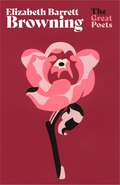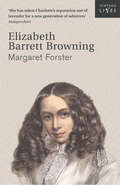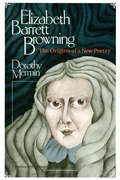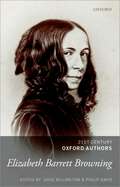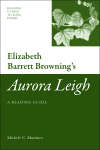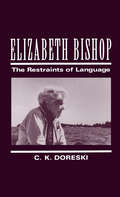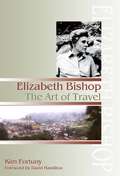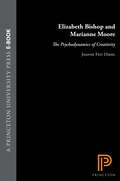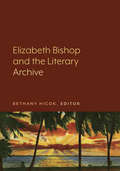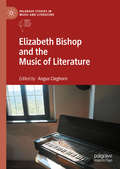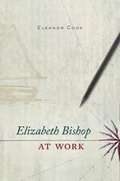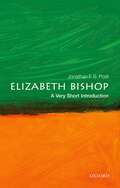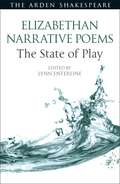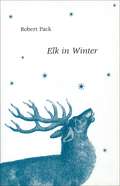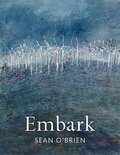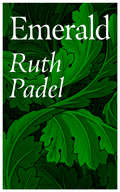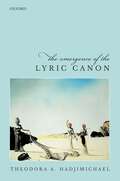- Table View
- List View
Eliot's Objective Correlative: Tradition or Individual Talent: Contributions to the History of a Topos
by Flemming OlsenEliot's dictum about the objective correlative has often been quoted but rarely analysed. This book traces the maxim to some of its sources and places it in a contemporary context. Eliot agreed with Locke about the necessity of sensory input, but for a poet to be able to create poetry, the input has to be processed by the poet's intellect. Respect for control of feelings and order of presentation were central to Eliot's conception of literary criticism. The result the objective correlative is not one word, but "a scene" or "a chain of events". Eliot's thinking was also inspired by late 19th century French critics like Gautier and Gourmont, whose terminology he not infrequently borrowed. But he chose the term "objective" out of respect for the prestige that still surrounded the Positivist paradigm. In its break-away from Positivist dogmas, criticism of art in the early 20th century was very much preoccupied with form. In poetry, that meant focus on the use and function of the word. That focus is perceptible everywhere in Eliot's criticism. Even though the idea of the objective correlative was not an original one, Eliot's treatment of it is interesting because he sees a seeming truism ("the right word in the right place") in a new light. He never developed the theory, but the thought is traceable in several of his critical essays. On account of its categorical and rudimentary form, the theory is not unproblematic: whose fault is it if the reader's response does not square with the poet's intention? And indeed, Eliot's own practice belies his theory -- witness the multifarious legitimate interpretations of his poems.
Elizabeth Barrett Browning: Much-loved poems from one of the greatest Romantic poets (The Great Poets)
by Elizabeth Barrett Browning'How do I love thee? Let me count the ways'Elizabeth Barrett Browning was a poet of passion, wit and conscience. She was also a woman who wrote to speak the truth about everything she knew - and she knew just what it was like to be a thinking woman in a society that wanted women to be weak. The eldest of twelve children, she wrote poetry from the age of eleven, and became a highly successful poet in her lifetime - and remains very much loved today.She was also a strong advocate for human rights, campaigning to abolish slavery and child labour, and her three-part poem A Curse for a Nation is a powerful polemic against the slave trade.'I heard an angel speak last night, and he said "write! Write a nation's curse for me, and send it over the western sea" '
Elizabeth Barrett Browning: Selected Poems (Everyman Ser.)
by Margaret ForsterThis biography of Elizabeth Barrett Browning, written with reference to Browning correspondence only recently available, argues that the poet was a strong and determined woman largely responsible for her own incarceration in Wimpole Street. The author traces her life from her early childhood and adolescence and explores her marriage. She draws a picture of early Victorian family life and aims to show that Elizabeth was a considerable and dedicated poet, self-willed, witty and courageous. Forster has also edited the companion volume "Selected Poems" of Elizabeth Barrett Browning, and is author of several other biographies.
Elizabeth Barrett Browning: The Origins of a New Poetry (Women in Culture and Society)
by Dorothy MerminElizabeth Barrett Browning (1806-61) was the first major woman poet in the English literary tradition. Her significance has been obscured in this century by her erasure from most literary histories and her exclusion from academic anthologies. Dorothy Mermin's critical and biographical study argues for Barrett Browning's originative role in both the Victorian poetic tradition and the development of women's literature. Barrett Browning's place at the wellhead of a new female tradition remains the single most important fact about her in terms of literary history, and it was central to her self-consciousness as a poet. Mermin's study shows that Barrett Browning's anomalous situation was constantly present to her imagination and that questions of gender shaped almost everything she wrote. Mermin argues that Barrett Browning's poetry covertly inspects and dismantles the barriers set in her path by gender and that in her major works—Sonnets from the Portuguese, Aurora Leigh, her best political poems, "A Musical Instrument"—difficulty is turned into triumph, incorporating the author's femininity, her situation as a woman poet, and her increasingly substantial fame. Mermin skillfully interweaves biography and close readings of the poems to show precisely how Barrett Browning's life as a woman writer is a part of the essential meaning of her art. Both her personal and her literary achievements are exceptionally well documented, especially for her formative years. Mermin makes extensive use of the poet's early essays, a diary covering most of her twenty-sixth year, and the enormous number of letters that have survived. Ranging from her earliest ambitions through her long periods of discouragement and illness to her happy married life with Robert Browning, this comprehensive study of Elizabeth Barrett Browning is essential reading for students of the Victorian period, English literature, and women's studies.
Elizabeth Barrett Browning: Selected Writings (21st-Century Oxford Authors)
This volume in the 21st Century Oxford Authors series offers students and readers a comprehensive selection of the work of the poet Elizabeth Barrett Browning (1806-1861). Accompanied by full scholarly apparatus, this authoritative edition enables students to study Barrett Browning's work within the rich context of her life and writing career. The revaluation of Elizabeth Barrett Browning's work by feminist scholars has made her an established author in university syllabuses in Britain and in America. Yet the reception of Barrett Browning as a writer within an explicitly female tradition has tended to limit the appreciation of her wider contribution to English literary culture in the nineteenth century, just as her popular image as a ringleted romantic heroine served sentimentally to eclipse her role as a literary pioneer. This edition complements or corrects these emphases by being the first edition dedicated to witnessing the progress and growth of the poet's creative direction—from her juvenilia through to her major achievements and beyond. The selection of works presented here appear in the order in which they were originally published, enabling students and readers to experience the contours of Barrett Browning's poetic career. Thus, following selections from published juvenilia, The Battle of Marathon (1820) and 'An Essay on Mind' and Other Poems (1826) and from 'Prometheus Bound' and Miscellaneous Poems (1833), there are more extensive selections from 'The Seraphim' and Other Poems (1838), from Poems 1844 and from Poems 1850 including the full text of Sonnets from the Portuguese. Substantial excerpts from Casa Guidi Windows (1851) is followed by the full text of Aurora Leigh (1857) and by selections from the posthumous Last Poems (1862). These individual sections are supplemented by careful selections (also chronologically ordered) from the correspondence, including the courtship letters with Robert Browning, and, where applicable, from poetry unpublished in the nineteenth century. Explanatory notes and commentary are included, to enhance the study, understanding, and enjoyment of these works, and the edition includes an Introduction to the life and works of Barrett Browning, and a Chronology.
Elizabeth Barrett Browning's 'Aurora Leigh': A Reading Guide (Reading Guides to Long Poems)
by Michele MartinezElizabeth Barrett-Browning's ambitious and challenging epic, 'Aurora Leigh' is illuminated for twenty-first century readers by Michele C. Martinez's Reading Guide. A clear commentary on core sections of the poem, as well as a range of interpretative frameworks, offer a genuinely new appreciation of this great poem.
Elizabeth Bishop: The Restraints Of Language
by C. K. DoreskiThis illuminating study examines Elizabeth Bishop's rhetorical strategies and the way they shape the formal and thematic movements of her poetry and stories. Unlike other recent studies of Bishop, Doreski's does not concern itself primarily with her visual imagery, but rather deals with her poetry as a series of linguistic strategies designed to create the maximum illusion of representation while resisting the romantic devices of self-revelation and solipsistic narration. Doreski argues that Bishop takes advantage of the inadequacies of language, and with a postmodern sense of limitation explores the gaps and silences narrative must bridge with the mundane, the patently inadequate, leaving an air of emotional intimacy without committing itself to the banality of full exposure. This study finds the poems and stories mutually illuminating, but while moving back and forth among her various works, acknowledges the intelligent ordering of the volumes Bishop published in her lifetime.
Elizabeth Bishop: The Art Of Travel
by Kim FortunyKim Fortuny argues that Bishop's travel poetry reveals a political and social consciousness that, until fairly recently, has largely been seen as absent from her poetry and her life. Fortuny argues that questions of travel bring up questions of form in Bi
Elizabeth Bishop and Marianne Moore: The Psychodynamics of Creativity
by Joanne Feit DiehlThis highly innovative work on poetic influence among women writers focuses on the relationship between modernist poet Elizabeth Bishop and her mentor Marianne Moore. Departing from Freudian models of influence theory that ignore the question of maternal presence, Joanne Diehl applies the psychoanalytic insights of object relations theorists Melanie Klein and Christopher Bollas to woman-to-woman literary transactions. She lays the groundwork for a far-reaching critical approach as she shows that Bishop, mourning her separation from her natural mother, strives to balance gratitude toward Moore, her literary mother, with a potentially disabling envy.Diehl begins by exploring Bishop's memoir of Moore, "Efforts of Affection," as an attempt by Bishop to verify Moore's uniqueness in order to defend herself against her predecessor's almost overwhelming originality. She then offers an intertextual reading of the two writers' works that inquires into Bishop's ambivalence toward Moore. In an analysis of "Crusoe in England" and "In the Village," Diehl exposes the restorative impulses that fuel aesthetic creation and investigates how Bishop thematizes an understanding of literary production as a process of psychic compensation.
Elizabeth Bishop and Marianne Moore: The Psychodynamics of Creativity
by Joanne Feit DiehlThis highly innovative work on poetic influence among women writers focuses on the relationship between modernist poet Elizabeth Bishop and her mentor Marianne Moore. Departing from Freudian models of influence theory that ignore the question of maternal presence, Joanne Diehl applies the psychoanalytic insights of object relations theorists Melanie Klein and Christopher Bollas to woman-to-woman literary transactions. She lays the groundwork for a far-reaching critical approach as she shows that Bishop, mourning her separation from her natural mother, strives to balance gratitude toward Moore, her literary mother, with a potentially disabling envy.Diehl begins by exploring Bishop's memoir of Moore, "Efforts of Affection," as an attempt by Bishop to verify Moore's uniqueness in order to defend herself against her predecessor's almost overwhelming originality. She then offers an intertextual reading of the two writers' works that inquires into Bishop's ambivalence toward Moore. In an analysis of "Crusoe in England" and "In the Village," Diehl exposes the restorative impulses that fuel aesthetic creation and investigates how Bishop thematizes an understanding of literary production as a process of psychic compensation.
Elizabeth Bishop and Marianne Moore: The Psychodynamics of Creativity
by Joanne Feit DiehlThis highly innovative work on poetic influence among women writers focuses on the relationship between modernist poet Elizabeth Bishop and her mentor Marianne Moore. Departing from Freudian models of influence theory that ignore the question of maternal presence, Joanne Diehl applies the psychoanalytic insights of object relations theorists Melanie Klein and Christopher Bollas to woman-to-woman literary transactions. She lays the groundwork for a far-reaching critical approach as she shows that Bishop, mourning her separation from her natural mother, strives to balance gratitude toward Moore, her literary mother, with a potentially disabling envy.Diehl begins by exploring Bishop's memoir of Moore, "Efforts of Affection," as an attempt by Bishop to verify Moore's uniqueness in order to defend herself against her predecessor's almost overwhelming originality. She then offers an intertextual reading of the two writers' works that inquires into Bishop's ambivalence toward Moore. In an analysis of "Crusoe in England" and "In the Village," Diehl exposes the restorative impulses that fuel aesthetic creation and investigates how Bishop thematizes an understanding of literary production as a process of psychic compensation.
Elizabeth Bishop and the Literary Archive
by Bethany HicokIn a life full of chaos and travel, Elizabeth Bishop managed to preserve and even partially catalog, a large collection—more than 3,500 pages of drafts of poems and prose, notebooks, memorabilia, artwork, hundreds of letters to major poets and writers, and thousands of books—now housed at Vassar College. Informed by archival theory and practice, as well as a deep appreciation of Bishop’s poetics, the collection charts new territory for teaching and reading American poetry at the intersection of the institutional archive, literary study, the liberal arts college, and the digital humanities. The fifteen essays in this collection use this archive as a subject, and, for the first time, argue for the critical importance of working with and describing original documents in order to understand the relationship between this most archival of poets and her own archive. This collection features a unique set of interdisciplinary scholars, archivists, translators, and poets, who approach the archive collaboratively and from multiple perspectives. The contributions explore remarkable new acquisitions, such as Bishop’s letters to her psychoanalyst, one of the most detailed psychosexual memoirs of any twentieth century poet and the exuberant correspondence with her final partner, Alice Methfessel, an important series of queer love letters of the 20th century. Lever Press’s digital environment allows the contributors to present some of the visual experience of the archive, such as Bishop’s extraordinary “multi-medial” and “multimodal” notebooks, in order to reveal aspects of the poet’s complex composition process.
Elizabeth Bishop and the Music of Literature (Palgrave Studies in Music and Literature)
by Angus CleghornElizabeth Bishop and the Music of Literature brings together the latest understandings of how central music was to Bishop’s writing. This collection considers Bishop’s reworking of metrical and rhythmic forms of poetry; the increasing presence of prosaic utterances into speech-soundscapes; how musical poetry intones new modes of thinking through aural vision; how Bishop transforms traditionally distasteful tones of violence, banality, and commerce into innovative poetry; how her diverse, lifelong musical education (North American, European, Brazilian) affects her work; and also how her diverse musical settings have inspired global contemporary composers. The essays flesh out the missing elements of music, sound, and voice in previous research that are crucial to understanding how Bishop’s writing continues to dazzle readers and inspire artists in surprising ways.
Elizabeth Bishop at Work
by Eleanor CookCritics and biographers praise Elizabeth Bishop’s poetry but have little to say about how it does its sublime work—in the ear and in the mind’s eye. Eleanor Cook examines in detail Bishop’s diction, syntax, rhythm, and meter, her acute sense of place, and her attention to the natural world. Writers, readers, and teachers will all benefit.
Elizabeth Bishop at Work
by Eleanor CookCritics and biographers praise Elizabeth Bishop’s poetry but have little to say about how it does its sublime work—in the ear and in the mind’s eye. Eleanor Cook examines in detail Bishop’s diction, syntax, rhythm, and meter, her acute sense of place, and her attention to the natural world. Writers, readers, and teachers will all benefit.
Elizabeth Bishop: A Very Short Introduction (Very Short Introductions)
by Jonathan F. PostVery Short Introductions: Brilliant, Sharp, Inspiring Elizabeth Bishop has been described as the 'best-loved' poet in English of the second half of the twentieth century. This Very Short Introduction explores the 90 or so published poems that are at the core of her remarkable canon of verse. Drawing on biographical and critical material, Jonathan Post also makes frequent use of Bishop's letters and commentary by fellow poets, including Marianne Moore, Robert Lowell, and James Merrill to illuminate her writing and contemporary literary landscape. Throughout, Post places Bishop's lyric poetry within the context of her life and aesthetic values, showing how these shaped her work. The book covers a wide range of core themes present in her poetry, including her powerful use of description, the environment, balance, and ideas of love and loss, as well as looking at Bishop's interest in the visual arts. ABOUT THE SERIES: The Very Short Introductions series from Oxford University Press contains hundreds of titles in almost every subject area. These pocket-sized books are the perfect way to get ahead in a new subject quickly. Our expert authors combine facts, analysis, perspective, new ideas, and enthusiasm to make interesting and challenging topics highly readable.
Elizabeth Bishop: A Very Short Introduction (Very Short Introductions)
by Jonathan F. PostVery Short Introductions: Brilliant, Sharp, Inspiring Elizabeth Bishop has been described as the 'best-loved' poet in English of the second half of the twentieth century. This Very Short Introduction explores the 90 or so published poems that are at the core of her remarkable canon of verse. Drawing on biographical and critical material, Jonathan Post also makes frequent use of Bishop's letters and commentary by fellow poets, including Marianne Moore, Robert Lowell, and James Merrill to illuminate her writing and contemporary literary landscape. Throughout, Post places Bishop's lyric poetry within the context of her life and aesthetic values, showing how these shaped her work. The book covers a wide range of core themes present in her poetry, including her powerful use of description, the environment, balance, and ideas of love and loss, as well as looking at Bishop's interest in the visual arts. ABOUT THE SERIES: The Very Short Introductions series from Oxford University Press contains hundreds of titles in almost every subject area. These pocket-sized books are the perfect way to get ahead in a new subject quickly. Our expert authors combine facts, analysis, perspective, new ideas, and enthusiasm to make interesting and challenging topics highly readable.
Elizabethan Narrative Poems: The State of Play (Arden Shakespeare The State of Play)
by Lena Cowen Orlin Ann ThompsonTracing the development of narrative verse in London's literary circles during the 1590s, this volume puts Shakespeare's Venus and Adonis and The Rape of Lucrece into conversation with poems by a wide variety of contemporary writers, including Thomas Lodge, Francis Beaumont, Christopher Marlowe, Thomas Heywood, Thomas Campion and Edmund Spenser. Chapters investigate the complexities of this literary conversation and contribute for the current, vigorous reassessment of humanism's intended consequences by drawing attention to the highly diverse forms of early modern classicism as well as the complex connection between Latin pedagogy and vernacular poetic invention.Key themes and topics include:-Epyllia, masculinity and sexuality-Classicism and commerce-Genre and mimesis-Rhetoric and aesthetics
Elizabethan Narrative Poems: The State of Play (Arden Shakespeare The State of Play)
by Lena Cowen Orlin Ann ThompsonTracing the development of narrative verse in London's literary circles during the 1590s, this volume puts Shakespeare's Venus and Adonis and The Rape of Lucrece into conversation with poems by a wide variety of contemporary writers, including Thomas Lodge, Francis Beaumont, Christopher Marlowe, Thomas Heywood, Thomas Campion and Edmund Spenser. Chapters investigate the complexities of this literary conversation and contribute for the current, vigorous reassessment of humanism's intended consequences by drawing attention to the highly diverse forms of early modern classicism as well as the complex connection between Latin pedagogy and vernacular poetic invention.Key themes and topics include:-Epyllia, masculinity and sexuality-Classicism and commerce-Genre and mimesis-Rhetoric and aesthetics
Elk in Winter
by Robert PackRobert Pack is a narrative master blessed with a keen ear for everyday speech. In poems that recall Robert Frost's meditative regard of nature, Pack's newest collection, Elk in Winter, resolves universal questions in the particular, the personal, and the intimate. This rich and varied volume moves from comedy to elegy, from lyric to narrative, in which individual characters are revealed and rendered symbolic by the stories that enclose them. What finally unites the poems of Elk in Winter is Pack's desire to appeal to the ear as much as to the heart, and to discover and reveal the passionate music of ideas.
Elk in Winter
by Robert PackRobert Pack is a narrative master blessed with a keen ear for everyday speech. In poems that recall Robert Frost's meditative regard of nature, Pack's newest collection, Elk in Winter, resolves universal questions in the particular, the personal, and the intimate. This rich and varied volume moves from comedy to elegy, from lyric to narrative, in which individual characters are revealed and rendered symbolic by the stories that enclose them. What finally unites the poems of Elk in Winter is Pack's desire to appeal to the ear as much as to the heart, and to discover and reveal the passionate music of ideas.
Elk in Winter
by Robert PackRobert Pack is a narrative master blessed with a keen ear for everyday speech. In poems that recall Robert Frost's meditative regard of nature, Pack's newest collection, Elk in Winter, resolves universal questions in the particular, the personal, and the intimate. This rich and varied volume moves from comedy to elegy, from lyric to narrative, in which individual characters are revealed and rendered symbolic by the stories that enclose them. What finally unites the poems of Elk in Winter is Pack's desire to appeal to the ear as much as to the heart, and to discover and reveal the passionate music of ideas.
Embark
by Sean O'BrienA new collection by Sean O’Brien – ‘Auden’s true inheritor’, and one of our wisest poetic chronographers – is not just a literary event, but also, invariably, a reckoning of the times. Given the nature of our times, his voice is an essential one: there is no other poet currently writing with O’Brien’s intellectual authority, historical literacy and sheer command of the facts. Embark also registers our unique cultural climacteric, where the larger crises of the planet – the pandemic and the terrifying spectre of revanchist nationalism among them – impact all of us, and where the illusion of a church-and-state separation of the personal and political can no longer hold. As the poet turns seventy, he shows us how the inevitable absences that age brings are assuaged by how we furnish them; the result is not just a logic made from loss and pain, but a music, a metaphysic, and finally a redemptive art. Embark reminds us of the enduring consolations of love, of friendship, of the freedoms and possible futures still afforded by the imagination – and, through O’Brien’s own exemplary model, of poetry itself.
Emerald
by Ruth PadelAn elegy to a lost mother, Emerald is the moving new collection from prize-winning poet Ruth Padel‘Here in deep earth, the blackblossom of mourning still sifting within meI remembered that emerald was my birthstone …’Prize-winning poet Ruth Padel’s heartfelt new collection is a grief observed: an elegy for her mother on her death at the age of ninety-seven.Exploring the riches of emerald lore, Padel follows the glint of green – ‘green for awakening / for bringing life back from the dead’ – from memories of her mother, a naturalist, to the black honeycomb of a Colombian emerald mine and sunset-pink of the Emerald City, Jaipur. Beneath everything shines the jewel itself, ‘the only stone in which the flaws are prized’. Beautifully carved and cadenced, Emerald is a moving chronicle of value and loss, and a celebration of all that is precious in the life that remains.
The Emergence of the Lyric Canon
by Theodora A. HadjimichaelThe Hellenistic period was an era of literary canons, of privileged texts and collections. One of the most stable of these consisted of the nine (rarely ten) lyric poets: whether the selection was based on poetic quality, popularity, or the availability of texts in the Library of Alexandria, the Lyric Canon offers a valuable and revealing window on the reception and survival of lyric in antiquity. This volume explores the complexities inherent in the process by which lyric poetry was canonized, and discusses questions connected with the textual transmission and preservation of lyric poems from the archaic period through to the Hellenistic era. It firstly contextualizes lyric poetry geographically, and then focuses on a broad range of sources that played a critical role in the survival of lyric poetry - in particular, comedy, Plato, Aristotle's Peripatetic school, and the Hellenistic scholars - to discuss the reception of the nine canonical lyric poets and their work. By exploring the ways in which fifth- and fourth-century sources interpreted lyric material, and the role they played both in the scholarly work of the Alexandrians and in the creation of what we conventionally call the Hellenistic Lyric Canon, it elucidates what can be defined as the prevailing pattern in the transmission of lyric poetry, as well as the place of Bacchylides as a puzzling exception to this norm. The overall discussion conclusively demonstrates that the canonizing process of the lyric poets was already at work from the fifth century BC and that it is reflected both in the evaluation of lyric by fourth-century thinkers and in the activities of the Hellenistic scholars in the Library of Alexandria.

